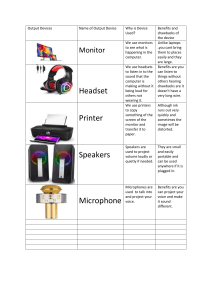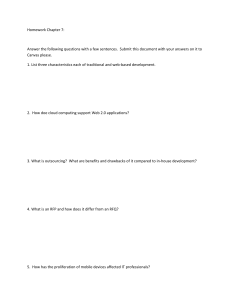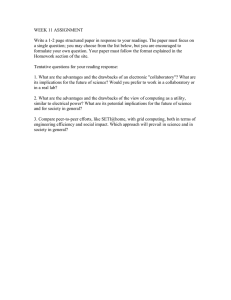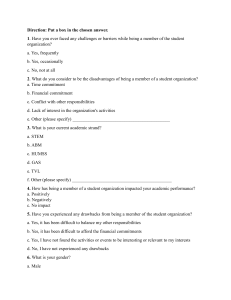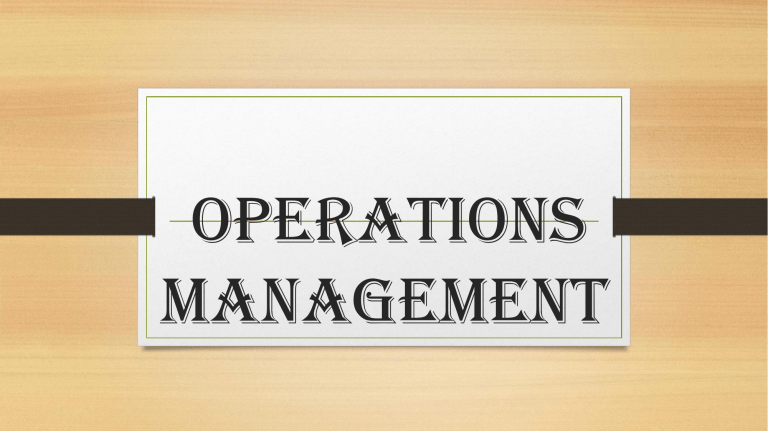
OPERATIONS MANAGEMENT CAPACITY UTILIZATION “Proportion of maximum capacity/output currently being achieved” BENEFITS OF FULL CAPACITY UTILIZATION • • • • Job security Better business image Economies of scale Better quality product Current output x 100 Maximum output DRAWBACKS OF FULL CAPACITY UTILIZATION • Planning and scheduling costs • Stress on workforce • Supply increase – price decrease – profits compromised over productivity • Lose orders from new customers How to cope up? SPARE CAPACITY – LONG TERM • Enter new markets • Rationalization SPARE CAPACITY – SHORT TERM • Price • Promotion • Deals CAPACITY SHORTAGE – LONG TERM • Capital investment in new production facilities • Outsourcing CAPACITY SHORTAGE – SHORT TERM • Outsourcing OUTSOURCING “Using another business or any third party to undertake part of a production process rather than doing it within the business” BENEFITS • • • • • Reduction in operating costs Increased flexibility Improved company focus Access to quality service or resources Freed-up internal resources DRAWBACKS • • • • Loss of jobs within the business Quality issues Customer resistance Security risk QUALITY “Relates to features of a product or service that allow it to satisfy customer wants” Quality control “Process of checking, usually the finished good or service as it is being provided to customers” STAGES BENEFITS 1. Prevention 2. Inspection 3. Correction and improvement • Quality consciousness in employees • Customer satisfaction DRAWBACKS • • Monotonousness Low employee morale QUALITY ASSURANCE “Process of checking whether a product or service meets particular quality standards through inspection of each stage of production” BENEFITS OVER QUALITY CONTROL: DRAWBACKS: • Job enrichment Herzberg’s theory • • • Reworking possible • Improved quality • Improved communication • Increased motivation • Time-saving Inspection costs May mentally exhaust workers as extra attention needed on each unit QUALITY ASSURANCE – how does it work? SUPPLIERS order raw materials PURCHASING DEPARTMENT PRODUCTION DEPARTMENT handling, storing and distribution of raw materials INBOUND LOGISTICS OUTBOUND LOGISTICS handling, storing and distribution of finished goods input, process, output RETAILERS TOTAL QUALITY MANAGEMENT (TQM) “A system that appreciates that everyone within an organization contributes to overall quality of the product/service” FEATURES BENEFITS DRAWBACKS • Quality chains • Company policy and accountability • Zero defects • Improved focus on • • customer needs • Potential wastage reduction • Encourages team approach • Better communication • • Training costs Strong commitment of workforce Regular audits required Product may be ignored while enforcing the process Quality circles “Refers to involving staff to improve quality, where employees in small groups discuss quality issues” ENCOURAGES • Team-working • Worker participation • Full use of employees’ knowledge and experience BENCHMARKING “Process of identifying best processes by which products are created and delivered” BENEFITS • • • Faster and cheaper Increase internal competitiveness Ideas for improvement if workforce involved in business discussion DRAWBACKS • • Ideas can be copied Difficult to recover costs incurred to improve benchmarking system Benchmarking - implementation Research on areas of improvement in the business Deciding how improvements can be made to those areas Identify best practice in other businesses Keep up to the exchange of info with other businesses Compare best practice to existing processes Amend the existing procedures to improve performance Evaluate how beneficial the changes have been. Lean production “The philosophy of “reducing wastage” whilst ensuring quality to be maintained” Methods of lean production JUST IN TIME SIMULTANEOUS ENGINEERING KAIZEN CELL PRODUCTION FLEXIBLE SPECIALISMS JUST IN TIME “An inventory management system, that lines up raw material orders from suppliers according to production schedules” BENEFITS • Lower holding costs • Improved cash flow • Increase efficiency DRAWBACKS • Less/no room for errors • Training costs • Machine maintenance costs may rise as company may be unable to afford machine breakdowns KAIZEN Japanese word meaning “improvement” “A philosophy that states, ‘improvement in workers productivity arise from continual increases in productivity rather than one-off increases through technology” Production One-off improvement Time kaizen REQUIREMENTS • Theory Y • Work experience is as important as theoretical knowledge BENEFITS • Feeling of responsibility and ownership in workers • Team-working DRAWBACKS • Training costs • May be seen as greater work rather than an opportunity for development Cell production “Production is reorganized into separate identifiable units known as ‘cells’ where workers are required to undertake a complete unit of work” BENEFITS • Reduce worker alienation • Feeling of responsibility • Team-working • Motivation • Improved communication DRAWBACKS • Training costs • Invest in technology Simultaneous engineering “A time based management strategy, implemented by rearranging the sequence of activities required before a product launch, in a simultaneous order rather than on a sequential basis” BENEFITS • Reduce the need of modifying products, post launch • First mover advantages Project Management – Critical path analysis “A modern management technique used to determine the minimum time it will take for a project to be completed whilst achieving preset targets of quality, time and cost” BENEFITS DRAWBACKS • Earliest start time – plan resources accordingly • Latest finish time – ensure timely completion of project • Critical activities – allow steps to ensure these are not delayed • Transfer of resources from noncritical activities to critical activities - difficult? • Accuracy of duration estimates • External influences accounted for? CRITICAL PATH ANALYSIS – KEY TERMS CRITICAL PATH EARLIEST START TIME LATEST FINISH TIME CRITICAL ACTIVITIES NON-CRITICAL ACTIVITIES MINIMUM DURATION TOTAL FLOAT FREE FLOAT LOGICAL DEPENDANCE DUMMY ACTIVITY


